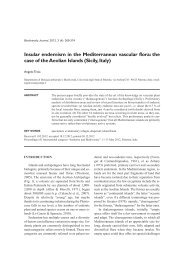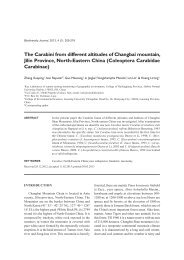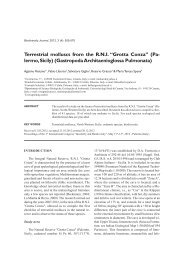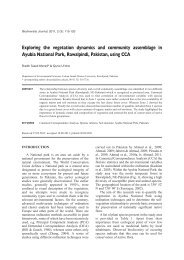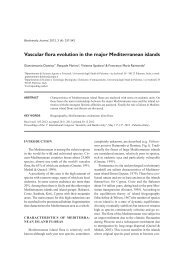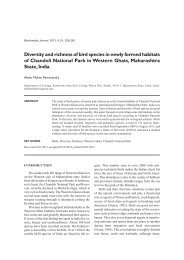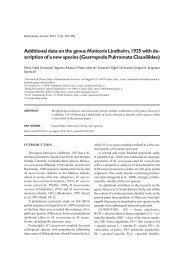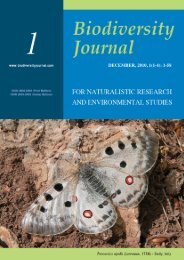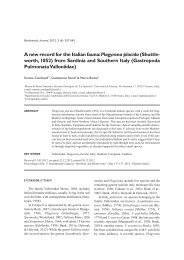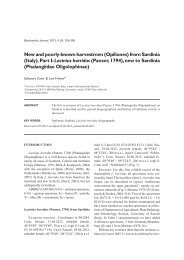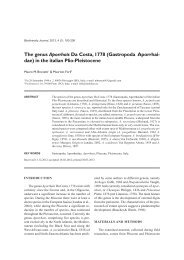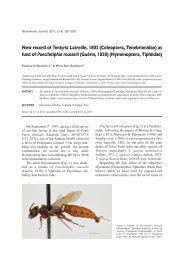LAND SNAILS SICILY - Biodiversity Journal
LAND SNAILS SICILY - Biodiversity Journal
LAND SNAILS SICILY - Biodiversity Journal
You also want an ePaper? Increase the reach of your titles
YUMPU automatically turns print PDFs into web optimized ePapers that Google loves.
<strong>Biodiversity</strong> <strong>Journal</strong>, 2012, 3 (3): 201-228<br />
New and little known land snails from Sicily (Mollusca<br />
Gastropoda)<br />
Fabio Liberto 1 , Salvatore Giglio 2 , Maria Stella Colomba 3* & Ignazio Sparacio 4<br />
1 Strada Provinciale Cefalù-Gibilmanna n. 93, 90015 Cefalù, Italy; email: fabioliberto@alice.it<br />
2 Contrada Settefrati, 90015 Cefalù, Italy; email: hallucigenia@tiscali.it<br />
3 Università di Urbino, Dept. of Biomolecular Sciences, via Maggetti n. 22, 61029 Urbino, Italy; email: mariastella.colomba@uniurb.it<br />
4 Via E. Notarbartolo n.54 int. 13, 90145 Palermo, Italy; e-mail: isparacio@inwind.it<br />
* Corresponding author<br />
ABSTRACT<br />
KEY WORDS<br />
In the present paper are reported new and little known land snails from Sicily (Mollusca<br />
Gastropoda). Particularly, Platyla similis (Reinhardt, 1880) (Aciculidae) and Rumina saharica<br />
Pallary, 1901 (Subulinidae) are first recorded in the island; new taxonomic data,<br />
useful for a better systematic classification, are provided on two little-known taxa, Lampedusa<br />
lopadusae nodulosa Monterosato, 1892 (Clausiliidae) and Cernuella (Cernuella)<br />
tineana (Benoit, 1862) (Hygromiidae); and finally, a new species of slug, Tandonia marinellii<br />
n. sp. (Milacidae), currently known from North-Western Sicily, is described.<br />
Mollusca; land snails; Sicily; taxonomy; new species.<br />
Received 10.07.2012; accepted 26.08.2012; printed 30.09.2012<br />
INTRODUCTION<br />
During 19 th century several taxa of terrestrial<br />
molluscs of Sicily were established, many of<br />
which are still little known and of uncertain taxonomic<br />
status, nevertheless some genera or families<br />
of molluscs, including slugs, have been neglected<br />
for a long time. The study of terrestrial molluscs<br />
of Sicily undertaken by present authors in the last<br />
decade, despite the complexity of the subject, continues<br />
with this further contribution in which some<br />
new faunal reports are provided, little known taxa<br />
are examined and, in addition, a new species of<br />
slug is described.<br />
ACRONYMS. APP = anterior portion of palatal<br />
plica; BC = bursa copulatrix; BCD = diverticulum of<br />
bursa copulatrix; CL = columellar lamella; DE = distal<br />
epiphallus; DG = digitiform glands; DSC = dart sac<br />
complex; DBC = duct of the bursa copulatrix;<br />
DCP = distal caviti of the penis; DGS = dart gun;<br />
DG = digitiform glands; DSC = dart sac complex;<br />
DSO = dart sac opening; E = epiphallus; F = flagellum;<br />
FO = free ovidutto; FR = frenula; G = penial papilla;<br />
GA = genital atrium; ISO = inner stylophore<br />
opening; L = lunella; OSO = outer stylophore opening;<br />
P = penis; PCP = proximal caviti of the penis;<br />
PD = penial diverticulum; PE = proximal epiphallus;<br />
PL = parietal lamella; PLL = parallel lamella;<br />
PP = principal plica; PPP = posterior portion of (upper)<br />
palatal plica; PR = penial retractor muscle; SCL = subcolumellar<br />
lamella; SL = spiral lamella; SP = sutural<br />
plica/plicae; V= vagina; VAG = vaginal accessory<br />
gland; VC = vaginal chambre; VD = vas deferens;<br />
VP = vaginal pleats.<br />
The materials used for this study are deposited<br />
in the following Museums and private collections:<br />
M. Bodon collection, Italy, Genova (CB); D.P. Cilia<br />
collection, Santa Venera, Malta (CC); S. Giglio collection,<br />
Cefalù, Italy (CG); Laboratory of Cytogenetics<br />
and Molecular Biology, University of Urbino,<br />
Italy (LCMBU); F. Liberto collection, Cefalù, Italy<br />
(CL); Museo Civico di Storia naturale di Comiso,
202<br />
Italy (MCSNC); Museo Civico di Storia Naturale<br />
di Genova “G. Doria”, Italy (MSNG); G. Nardi collection,<br />
Nuvolera, Italy (CN), A. Reitano collection,<br />
Tremestieri Etneo, Italy (CR); I. Sparacio collection,<br />
Palermo, Italy (CS); The Steinhardt National Collections<br />
of Natural History, Zoological department,<br />
Tel-Aviv University, Israel (TAU).<br />
MATERIALS AND METHODS<br />
All specimens were collected by sight on the<br />
soil and under the rocks or by sieving litter and soil.<br />
Observations on ecology of these organisms and<br />
their feeding behavior were made directly in the<br />
field. Dry shells have been studied as regards size,<br />
colour, morphology, sculpture, aperture, plicae and<br />
lamellae, lunella and clausilium. Photographs were<br />
taken with a digital camera. In order to study and<br />
illustrate genital organs, the specimens were drowned<br />
in water and fixed in 75% ethanol.<br />
Reproductive apparatus was extracted by means<br />
of scalpel, scissors and needles. Illustrations of genitalia<br />
were sketched using a camera lucida. Height<br />
and maximum diameter of the shell along with<br />
some parts of genitalia were measured (in millimeters)<br />
by a digital gauge. Voucher specimens were<br />
stored in collections indicated below. Toponyms<br />
(place-names) are reported following the Portale<br />
Cartografico Nazionale (PCN, http://www.pcn.mi-<br />
F. LIberto, S. GIGLIo, M.S. CoLoMba & I. SparaCIo<br />
nambiente.it /PCN/), Map IGM 1:25000. Each locality<br />
and/or collection site is named in the original<br />
language (italian). The material used for the molecular<br />
analysis was collected on the field during February<br />
2012. All the specimens were studied and<br />
observed at the steromicroscope (Leica MZ 7.5).<br />
Genetic study described in the present study was<br />
based on a comparative analysis of COI partial sequences<br />
which are frequently used as markers in the<br />
investigation of evolutionary processes at the specific<br />
level. Briefly, the study was conducted by DNA isolation,<br />
PCR amplification, sequencing, alignment of<br />
the sequences and phylogenetic reconstructions<br />
using the Maximum Likelihood algorithm. For a detailed<br />
description see below.<br />
RESULTS<br />
Class Gastropoda Cuvier, 1795<br />
Ordo Architaenioglossa Haller 1890<br />
Family Aciculidae J.E.Gray, 1850<br />
Platyla similis (Reinhardt, 1880)<br />
ExAMINED MATERIAL. Italy, Sicily, Cefalù, Rocca<br />
di San Nicola, 37°59’07”N 14°02’42”E, 600 m,<br />
01.VI.2008, 6 specimens (CG); Cefalù, Cozzo Carcarello,<br />
37°59’29” N, 14°03’05”E; 320 m, 15.VI.2008,<br />
8 specimens (CL); idem, 23.VIII.2009, 22 specimens<br />
(CL); idem, 23.IV.2012, 12 specimens (CL).<br />
Figures 1,2. Shell of Platyla similis from Cefalù, Cozzo Calcarello, h: 2.32 - D: 0.89. Figure 3. Geographic distribution<br />
of Platyla similis (circles) and P. subdiaphana (squares) in Sicily (personal data).
DESCRIPTION. Morphologically, this sicilian population<br />
of P. similis has typical characters of the<br />
species: shell conical (Figs. 1-2), slender, colorless,<br />
height 2.16-2.58 mm, width 0.80-0.98 mm, with 4-<br />
5 whorls slightly convex, last portion of last whorl<br />
slightly ascending in relation to the penultimate,<br />
aperture slightly oblique, sinulus little depth, external<br />
peristomal rib consists of a weak thickening, not<br />
clearly defined anteriorly and posteriorly.<br />
BIOLOGY AND DISTRIBUTION. P. similis lives in<br />
woodland litter, on the soil, in the cracks and at the<br />
base of the calcareous rocks. P. similis has South-<br />
Oriental European distribution including Bulgaria,<br />
Croatia, Serbia, Greece, Romania, Kosovo, and<br />
Central and Southern Italy (Boeters et al., 1989;<br />
Bodon et al., 1995; Bodon & Cianfanelli, 2008;<br />
Bank, 2012).<br />
REMARKS. We report the presence of P. similis<br />
for the first time in Sicily, from Nothern Madonie<br />
mountains, on the calcareous rocks named “Rocca<br />
di San Nicola” and “Cozzo Calcarello”. Shells were<br />
collected by sieving litter and soil, sampled in<br />
cracks of the calcareous rock, at the base of rocky<br />
walls or under boulders in the woods of oaks.<br />
In Sicily it was known until now only the endemic<br />
species: P. subdiaphana (Bivona, 1839)<br />
(Boeters et al., 1989; Bodon et al., 1995; Bodon<br />
& Cianfanelli, 2008; Bank 2012) (Fig. 3). Boeters<br />
et al. (1989) distinguish all species of Platyla Moquin-Tandon,<br />
1856 into three groups on the basis<br />
of the presence or absence and conformation of<br />
the external peristomal rib (see also Bodon &<br />
Cianfanelli, 2008).<br />
P. similis is inserted into the second group characterized<br />
by an external peristomal rib not robust<br />
and not clearly delimited posteriorly. P. subdiaphana<br />
belongs to the third group characterized by<br />
a robust external peristomal rib bounded by a<br />
sharp line or by a large groove. P. subdiaphana,<br />
also, is distinguished from P. similis for bigger<br />
size (height 3.5-4.45 mm).<br />
Ordo Stylommatophora A. Schmidt, 1855<br />
Family Milacidae Germain, 1930<br />
Tandonia marinellii n. sp.<br />
ExAMINED MATERIAL. Holotypus: Italy, Sicily,<br />
Custonaci, Monte Sparagio, Pizzo Giacolamaro,<br />
New and little known land snails from Sicily (Mollusca Gastropoda)<br />
203<br />
38°03’18”N 12°44’35”E, 665 m, 08.I.2012 (MSNG<br />
56989). Paratypi: Italy, Sicily, Custonaci, Monte Cofano,<br />
38°06’11’’N 12°40’39’’E, 255 m, 14.IV.1991,<br />
2 specimens (CS); San Vito lo Capo, Macari, Pizzo<br />
Castelluzzo, 38°07’28”N 12°44’41”E, 364 m,<br />
II.2007, 3 specimens (CR); Erice, 38°02’24”N<br />
12°35’34”E, 500 m, 03.x.2011, 1 specimen (CN);<br />
Calatafimi, Cozzo Gessi, 37°54’44”N 12°50’41”E,<br />
264 m, 20.xI.2011, 3 specimens (CL); idem, 2 specimens<br />
(CG); Calatafimi, Monte Bernarco,<br />
37°54’56”N 12°49’45”E, 370 m, 20.xI.2011, 6 specimens<br />
(CL); Castellammare del Golfo, Fraginesi,<br />
38°01’06”N 12°50’08”E, 180 m, 4.xII.2011, 1 specimen<br />
(CS); Custonaci, Monte Sparagio, Pizzo Giacolamaro,<br />
38°03’18”N 12°44’35”E, 665 m, 8.I.2012,<br />
1 specimen (CL); idem, 1 specimen (TAU 76575);<br />
idem, 1 specimen (MCSNC 4411); Custonaci,<br />
Monte Sparagio, Pizzo Giacolamaro, 38°03’17”N<br />
12°44’57”E, 716 m, 4.II.2012, 8 specimens (CL);<br />
Trapani, contrada Chinèa, near the Lago Rubino,<br />
37°53’49”N 12°44’05”E, 260 m, 18.II.2012, 2 specimens<br />
(CS); Custonaci, Muciara, 38°03’27’’N<br />
12°43’64’’E, 542 m, 4.III.2012, 11 specimens (CS);<br />
idem, 2 specimens (MSNG 56990; MSNG 56991).<br />
DESCRIPTION OF HOLOTYPUS. Slug mediumsized,<br />
length 55 mm after preservation (the specimen<br />
is contracted). Clypeus about 1/3 of body<br />
length, superficially granulated, with horseshoeshaped<br />
groove, and a hollow near keel; evident carina<br />
running from clypeus to posterior apex of<br />
body. Body and mantle brownish-yellow with blackish<br />
pigment forming irregular reticulation and<br />
dots which disappear toward the sole, keel orange.<br />
Foot sole tripartite, creamy-coloured, mucus thick,<br />
viscous, white-yellowish. Shell (limacella) naillike,<br />
oval, well calcified, white, with apex posterior<br />
and situated on major axis, at the highest point,<br />
convex above, slightly concave ventrally (Figs. 18-<br />
20); length: 7.5 mm; diameter: 4.9 mm.<br />
Genitalia (Figs. 4-7, 11). Vas deferens thin, ending<br />
laterally at proximal epiphallus tip. Epiphallus<br />
very long (20 mm), divided by a slight constriction<br />
in a narrow cylindrical proximal portion with thin<br />
walls (proximal epiphallus) and in an ample conic<br />
distal portion with thick walls (distal epiphallus).<br />
Internally, the proximal epiphallus is crossed by<br />
around 15 anular crests more evident in the central<br />
zone, and 5-6 longitudinal folds in the slight broadening<br />
apical knob, while the distal epiphallus has<br />
a very narrow duct; penial retractor muscle ending
204<br />
F. LIberto, S. GIGLIo, M.S. CoLoMba & I. SparaCIo<br />
Figures 4-7. Genitalia of T. marinellii n. sp., holotypus: whole genitalia (Fig. 4), internal structure of vagina (Fig. 5), internal<br />
structure of penis (Fig. 6), internal structure of penis and epiphallus (Fig. 7).
New and little known land snails from Sicily (Mollusca Gastropoda) 205<br />
Figure 8. Spermatophore of the holotypus of T. marinellii n. sp. Figure 9. Anterior portion of spermatophore of T. marinellii<br />
from Calatafimi. Figure 10. Spermatophore of T. sowerbyi from Novara di Sicilia, Rocca Novara, Sicily. Figures<br />
11, 12. Scheme of genitalia of T. marinellii n.sp., (Fig. 11) and of T. sowerbyi by Wiktor (1987), modified (Fig. 12).
206<br />
laterally on penial complex where slight constriction<br />
separates distal epiphallus from proximal epiphallus.<br />
Border between epiphallus and penis<br />
externally evident, inside the epiphallus protrudes<br />
into the penis with a semispheric extension, bearing<br />
at its apex a small cylindrical papilla. Penis irregular,<br />
cylindrical, 11 mm long, approximately ½ of<br />
length of epiphallus, with thin walls, inside with<br />
some striations and divided by a constriction in two<br />
cavities: a narrower, oblong proximal cavity (8 mm)<br />
and a short, wide distal cavity (2.2 mm). A thin sheath<br />
envelopes the penial complex, keeping proximal<br />
epiphallus bent on the distal epiphallus and the<br />
penis contracted; wide and short genital atrium,<br />
with fine folds around the genital opening.<br />
Vagina long (9.8 mm), inside there are some discontinuous<br />
longitudinal folds. Vaginal accessory<br />
gland enters by means of thin canaliculi at about<br />
midway along vagina. An annular pad separates the<br />
real vagina from a small chamber (vaginal chamber)<br />
with thick, smooth wall, where the duct of<br />
bursa copulatrix and the free oviduct end. Duct of<br />
bursa copulatrix short and slender. Bursa copulatrix<br />
elongate with a narrow apical prolungation. Long<br />
and slender free oviduct, slightly wider near vagina.<br />
Spermatophore (Fig. 8) worm-like, glossy, golden.<br />
Anterior apex lacking (broken), the remaining<br />
anterior portion is regularly tubular and bare, only<br />
on the distal part there are some short spines (with<br />
4-5 apexes), the posterior portion is covered with<br />
some short spines with bifurcate point (two apexes)<br />
or simple (one apex); posterior apex of the spermatophora,<br />
bigger, completely covered of bifurcate or<br />
simple spines. The spermatofore was found in the<br />
channel of the bursa copulatrix with the posterior<br />
apex contained into "vaginal chamber".<br />
VARIABILITY. Body colour variable (Figs. 13-16)<br />
from uniform orange with some spots hardly visible<br />
to orange-brown speckled with darker patches; keel<br />
clear, orange or cream; clypeus with blackish horseshoe-shaped<br />
groove and sometimes with a dark<br />
central line; genitalia: proximal epiphallus and distal<br />
epiphallus generally have the same length, but<br />
in some specimens the proximal portion is slightly<br />
shorter; the epiphallus protrudes into the penis with<br />
a semispheric or conic extension, penis length varying<br />
from 6 mm to 10 mm; vagina length varies<br />
from 2 mm to 9 mm. Spermatophore variable in<br />
size (Fig. 9) and color from red to yellow-gold;<br />
F. LIberto, S. GIGLIo, M.S. CoLoMba & I. SparaCIo<br />
these were found in the channel of bursa copulatrix<br />
with the big apex contained into "vaginal chamber".<br />
ETIMOLOGY. The new species is dedicated to<br />
Aldo Marinelli (Roma), as sign of appreciation for<br />
creating the forum “Natura Mediterraneo” (available<br />
at: http://www.naturamediterraneo.com/forum/).<br />
BIOLOGY AND DISTRIBUTION. Species rather<br />
common in natural environments with forests, mediterranean<br />
maquis or garrigue, nocturnal, during<br />
the day specimens shelter under rocks and logs;<br />
sexual maturity occurs in winter. T. marinellii n.<br />
sp., at present, is known only from North-Western<br />
Sicily (Fig. 21).<br />
COMPARATIVE NOTES. T. sowerbyi (Férussac,<br />
1823) was the only known species in Sicily (Wagner,<br />
1931, Giusti, 1973; Manganelli et al., 1995;<br />
Bank 2012) (Fig. 21). In this region it seems to be<br />
native as widely widespread, especially in natural<br />
environments, and having been reported since 1800<br />
(Lessona & Pollonera, 1882 sub Amalia carinata<br />
and A. carinata var. oretea; Minà Palumbo, 1883<br />
sub Amalia carinata; Pollonera, 1891 sub Amalia<br />
carinata). The populations of eastern Sicily examined<br />
by us show the typical morphological characters<br />
of T. sowerbyi (Wiktor, 1987, Giusti et al.,<br />
1995) (Figs. 10, 12). The epiphallus in T. sowerbyi<br />
is of medium length and cone-shaped, while in T.<br />
marinellii n. sp. the epiphallus is very long and<br />
equipped with an evident proximal portion completely<br />
absent in T. sowerbyi; the penis retractor muscle<br />
in T. sowerbyi ends at about 2/3 of the length<br />
of the epiphallus, while in T. marinellii n. sp. ends<br />
at half the length of the epiphallus exactly where<br />
the distal portion ends and the proximal one begins;<br />
a pair of short supplementary muscles inserted at<br />
the distal end of epiphallus observed in T. sowerbyi,<br />
lack in the new species.<br />
The penis in T. sowerbyi is divided by a constriction<br />
in a short distal portion followed by a longer<br />
proximal chamber, while in T. marinellii a<br />
proximal long portion is followed by a short distal<br />
one, wide and sac-shaped; penial papilla in T. sowerbyi<br />
is squished, of vestigial type, while in T. marinellii<br />
is of cylindrical shape; the fold-like<br />
thickening (reduced "stimulator") present in T. sowerbyi,<br />
lacks in T. marinellii; the spermatophore in<br />
T. sowerbyi has a posterior portion covered with<br />
very branched spines (Fig. 10), whereas in T. marinellii<br />
is covered by scattered spines not branched or
New and little known land snails from Sicily (Mollusca Gastropoda) 207<br />
Figures 13-16. T. maninellii n.sp., Custonaci, Monte Sparagio, Giacolamaro, 08.I.2012: variability of the body colour. In<br />
a specimen (Fig. 16) is visible the white-yellowish mucus.
208<br />
F. LIberto, S. GIGLIo, M.S. CoLoMba & I. SparaCIo<br />
Figure 17. Maximum Likelihood consensus tree (rooted with respect to the genus Limax) inferred from a dataset of 83<br />
(seven sequences obtained in the present paper and 76 retrieved from GenBank database) mitochondrial COI gene partial<br />
sequences. Numbers above branches represent bootstrap values.
at most bifurcate with wider base, and the posterior<br />
apex is bigger.<br />
Examined material of Tandonia sowerbyi. Italy,<br />
Emilia Romagna, Castiglione dei Pepoli, Roncobilaccio,<br />
44°06’59’’N 11°13’42’’E, 593 m,<br />
5.xI.2011, 2 specimens (CS). Italy, Sicily: Castelbuono,<br />
Cozzo Luminario, Piano Sempria,<br />
37°54’18”N 14°03’59”E, 1192 m, x.1990, 4 specimens<br />
(CS); Palermo, Parco della Favorita, Vallone<br />
del Porco, 38°10’07”N 13°20’39”E, 243 m,<br />
13.xI.1990, 4 specimens (CS); Monreale, Bosco<br />
Ficuzza, Diga Scanzano, 37°55’14”N 13°22’25”E,<br />
536 m, 1.xII.1990, 6 specimens (CS); Palermo,<br />
Fiume Oreto, Ponte delle Grazie, 38°04’4”N<br />
13°19’25”E, 95 m, 19.xI.1990, 5 specimens (CS);<br />
idem, 3.xII.1990, 2 specimens (CS); Isnello, Contrada<br />
Montaspro, 37°54’42”N 13°59’30”E, 857 m,<br />
5.III.1991, 1 specimen (CS); Collesano, Contrada<br />
Croce, 37°55’23”N 13°55’20”E, 511 m, 5.III.1991,<br />
6 specimens (CS); Cammarata, Monte Cammarata,<br />
Cozzo Panepinto, 37°38’16”N 13°36’34”E, 984 m,<br />
III.1992, 4 specimens (CS); idem, 2 specimens<br />
(CL); Petralia Sottana, Fiume Imera Meridionale,<br />
37°48’26”N 14°05’01”E, 808 m, 2.xI.1992, 3 specimens<br />
(CS); San fratello, Monte Soro, Pizzo<br />
Muto, 37°56’16”N 14°38’16”E, 1410 m, x.2001,<br />
1 specimen (CS); idem, 1 specimen (CL); Melilli,<br />
Riserva Naturale Integrale Grotta Palombara, 2008<br />
(CR); Monreale, Ponte Arcera, 37°55’42”N<br />
13°23’01”E, 470 m, 14.xI.2008, 2 specimens,<br />
(CL); Melilli, Riserva Naturale Integrale Grotta Palombara,<br />
2008 (CR); Vizzini, Contrada Rubala,<br />
near the F. Vizzini, 37°08’28”N 14°44’15”E, 376<br />
m, 11.I.2009, 5 specimens (CL); Prizzi, Fontana<br />
Grande, 37°42’53”N 13°25’43”E, 800 m, 15.xI.2009,<br />
4 specimens (CL); Torrenova, Rocca Scovoni,<br />
Piano Scodoni, 38°05’38”N 14°41’26”E, 25 m,<br />
06.xII.2009, 1 specimen (CL); Castelbuono, S. Guglielmo,<br />
near the creek San Calogero, 37°55’04”N<br />
14°04’22”E, 670 m, I.2010, 3 specimens (CL); Novara<br />
di Sicilia, Rocca Novara, 37°59’35”N<br />
15°08’25”E, 1000 m, 07.xI.2010, 4 specimens<br />
(CL); Itala, Piano Fattaredda, 38°02’48”N<br />
15°25’09”E, 612 m, 12.xII.2010, 2 specimens<br />
(CL); Isnello, Vallone Montaspro, 37°54’18”N<br />
13°58’55”E, 783 m, 26.II.2012, 2 specimens (CL).<br />
Tandonia rustica (Millet, 1843) has an European<br />
central and southern distribution and is found<br />
in the northern regions of Italy and along the Apennines<br />
up to the central regions. This species is cha-<br />
New and little known land snails from Sicily (Mollusca Gastropoda) 209<br />
racterized by a very long epiphallus externally similar<br />
to that of T. marinellii. However, T. rustica<br />
is characterized by its whitish or creamy coloration,<br />
somewhat violetish, with numerous, small<br />
black dots; the penial complex (epiphallus+penis)<br />
is smaller (around 10 mm) compared to T. marinellii<br />
(20-31 mm), and has a different structure:<br />
penis proportionally shorter and epiphallus showing<br />
internally long longitudinal rows of papillae,<br />
penial papilla proportionally larger and much more<br />
ornate; the place where musculus retractor inserts<br />
is not constricted; atrium is narrow and tube-shaped<br />
while in T. marinellii is short and very broad.<br />
Examined material of Tandonia rustica. Italy,<br />
Emilia Romagna, Castiglione dei Pepoli, Roncobilaccio,<br />
5.xI.2011, 1 specimen (CS); Italy, Lombardia,<br />
Brescia, Valvestino, Armo, 45°46’N<br />
10°35’E, 666 m, 22.x.2000, 1 specimen (CN);<br />
idem, Anfo, S. Petronilla, 45°46’N 10°29’E, 524<br />
m, 4.V.2008, 1 specimen (CN); idem, Ghedi,<br />
45°24’N 10°16’E, 85 m, 20.Ix.1996, 1 specimen<br />
(CN), idem, Marone, Vello, 45°45’N 10°05’E, 200<br />
m, 01.V.2007, 1 specimen (CN).<br />
MOLECULAR ANALYSIS. Seven Tandonia specimens,<br />
three from Custonaci (TP) and four from<br />
Madonie mountains (PA), labelled as TCUS and<br />
TMAD respectively, were analyzed. Samples were<br />
stored in 75% Ethanol at -20 °C in test tubes. For<br />
each individual, a piece of about 40-50 mg was<br />
used for total DNA extraction. Pieces of each specimen<br />
were deposited as vouchers at University of<br />
Urbino, Lab. of cytogenetics and molecular biology.<br />
COI amplicons (654 bp) were obtained by<br />
LCO1490/HCO2198 universal primers (5’-<br />
GGTCAACAAATCATAAAGATATTGG-3’/5’-<br />
TAAACTTCAGGGTGACCAAAAAATCA-3’)<br />
as in Folmer et al. (1994) with a PCR cycle of 95<br />
°C for 5 min; 95 °C for 1 min, 42 °C for 1 min, 72<br />
°C for 1 min (37 cycles); 72 °C for 10 min. Sequencing<br />
of the purified PCR products was carried<br />
out using automated DNA sequencers at Eurofins<br />
MWG Operon (Germany). Finally, sequence chromatograms<br />
of each amplified fragment were browsed<br />
visually. Sequences generated in this study<br />
were analysed with additional seventy-six Limacidae<br />
COI sequences retrieved from GenBank (IDs:<br />
AF239733-34, AM259702-06, AM259712-14,<br />
EF128217, FJ481179, FJ481181, FJ606455-71,<br />
FJ606481, FJ606483, FJ606485, FJ606487,<br />
FJ606489, FJ606491, FJ606493, FJ606495,
210<br />
FJ606497, FJ606499, GQ145509, GQ145523,<br />
GQ145525, GQ145527, GQ145538-39, GQ145553,<br />
GQ145572-75, JN248291-99, JN248300-15; see also<br />
Reise et al., 2011). Sequences were visualized with<br />
BioEdit Sequence Alignment Editor 7 (Hall, 1999),<br />
aligned with the ClustalW option included in this<br />
software and double checked by eye. Standard measures<br />
of nucleotide polymorphism and phylogenetic<br />
analyses were conducted in MEGA 5.0.3 (Tamura<br />
et al., 2011). The best-fit evolution model of nucleotide<br />
substitution resulted GTR+G (General Time<br />
Reversible+Gamma). The evolutionary history was<br />
inferred by using the Maximum Likelihood method;<br />
the bootstrap consensus tree was inferred<br />
from 500 replicates; a discrete Gamma distribution<br />
was used to model evolutionary rate differences<br />
among sites (5 categories; +G, parameter = 0.4467).<br />
Codon positions included were 1st+2nd+3rd. All<br />
positions containing gaps and missing data were eliminated.<br />
Divergence among TCUS and TMAD<br />
groups (Dxy), assessed as p distance, was 5.9%.<br />
Although genetic differences (p distance) are<br />
only indicative when assigning a group to a given<br />
taxonomic rank, the distance we assessed (5.9%)<br />
between COI sequences obtained from specimens<br />
collected in Madonie mountains and Custonaci not<br />
only is in line with values considered discriminatory<br />
at the specific level in Mollusca (i.e. Herbert<br />
et al., 2003; Pfenninger et al., 2006), but it is even<br />
greater than estimated distances separating entities<br />
accepted as distinct species (L. corsicus/L. senensis,<br />
2.3%; L. ciminensis/L. senensis, 4.2%; L. minimus/L.<br />
wolterstorffi, 4.4%).<br />
In conclusion, phylogenetic tree (Fig. 17) and<br />
genetic distance between TCUS and TMAD groups<br />
firmly support the hypothesis that specimens from<br />
Custonaci and Madonie mountains belong to two<br />
distinct Tandonia species.<br />
REMARKS. The genus Tandonia Lessona & Pollonera,<br />
1882 has European-Mediterranean distribution<br />
extended to the Black Sea coasts (Wiktor, 1987,<br />
Giusti et al., 1995). In Italy it’s verified the presence<br />
of six species (Bank, 2012): T. nigra (C. Pfeiffer,<br />
1849), T. budapestensis (Hazay, 1880), T. robici<br />
(Simroth, 1884), T. rustica, T. simrothi (Hesse,<br />
1923), T. sowerbyi. Among them, T. sowerbyi and<br />
T. rustica are morphologically the more similar to<br />
T. marinellii n. sp. that, on the other hand, sharply<br />
differs from these taxa for all the characters described<br />
above. Noteworthy, in bibliography about Si-<br />
F. LIberto, S. GIGLIo, M.S. CoLoMba & I. SparaCIo<br />
cilian and surrounding geographical areas a few<br />
taxa of uncertain taxonomic value are reported.<br />
These taxa are examined below. Amalia marginata<br />
var. oretea Lessona & Pollonera, 1882 is a taxon<br />
described for Sicily (locus typicus: “Palermo presso<br />
il fiume Oreto”) only on external morphological<br />
characters: “Typica, clipeo tantum zonula nigra longitudinali<br />
mediana instructo” (Lessona & Pollonera,<br />
1882). The body coloration in Tandonia (=Amalia<br />
Moquin-Tandon, 1855) is quite variable and topotypic<br />
specimens studied by us can be traced back,<br />
due to the shape of genitalia, to T. sowerbyi (Figs.<br />
10-12). A. marginata var. oretea is then confirmed<br />
as a synonym of T. sowerbyi (Giusti, 1973; Bank,<br />
2012). It would have been critical examination of<br />
typical material, but the specimens described by<br />
Lessona & Pollonera (1882) are no longer available<br />
in their collection housed at the Museo Regionale<br />
di Scienze Naturali di Torino (E. Gavetti in litteris).<br />
Bourguignat (1877) established a new genus and<br />
a new species, Palizzolia monterosati, on a single<br />
Milacidae shell from Calatafimi with the following<br />
description: “Limacelle ovalaire, épaisse, très-bombée<br />
(comme sphérique) en dessous, caractérisée en<br />
dessus: 1° Par une surface plane, sur laquelle on distingue<br />
un cucléus médian, circonscrit par une profonde<br />
dépression; 2° par une forte échancrure à sa<br />
partie médiane supérieure”<br />
Lessona & Pollonera (1882) recognise in Palizzolia<br />
diagnostic characters of the shell of Milacidae<br />
(oval, medial nucleus) and put Palizzolia in homonymy<br />
with the genus Milax Gray, 1855 (sub Amalia).<br />
This choise was followed by Cockerell (1991),<br />
Kennard & Woodward (1926), Wiktor (1987) although<br />
with a question mark, Alzona (1971) and<br />
Barker (1999). However, the shell of Milacidae offers<br />
no morphological characters useful for a reliable<br />
classification at both genus and species level<br />
and therefore it is possible that Palizzolia could be<br />
an older synonym of Tandonia.<br />
The taxon monterosati was usually treated as<br />
doubtful species (Lessona & Pollonera, 1882; Minà<br />
Palumbo, 1883; Cockerell & Collinge, 1893; Wiktor,<br />
1987; Cockerell, 1991;) because the rear hollow,<br />
the considerable thickening of the lower part<br />
of the shell and the groove around the apex are abnormalities<br />
detectable in different species of both<br />
Milax and Tandonia genera; only Kennard & Woodward<br />
(1926) pose the taxon monterosati in synonymy<br />
with Milax gagates (Draparnaud, 1801).
Giusti et al. (1995) note that Tandonia shells are<br />
generally thicker and oval, however examination of<br />
the Palizzolia monterosati type (MHNG BGT<br />
2385) (Figs. 22-26) does not provide indications<br />
New and little known land snails from Sicily (Mollusca Gastropoda)<br />
Figures 18-20. Shell (limacella) of T. marinellii n.sp., holotypus, h: 7.65 mm - D: 5.05 mm. Figure 21. Geographic<br />
distribution of Tandonia marinellii n. sp (circles) and T. sowerbyi (squares) in Sicily (personal data). Figures 22-24.<br />
Typus of Palizzolia monterosati (MHNG BGT 2385), h: 4.5 mm - D: 3.8 mm, thickness 2.2 mm. Figure 25. Original<br />
label of P. monterosati (MHNG BGT 2385). Figure 26. Four sequential visions of the ampoule rotated progressively so<br />
that to allow the overall vision of the label of P. monterosati (MHNG BGT 2385).<br />
211<br />
for univocal taxonomic attribution. At Calatafimi,<br />
locus typicus of P. monterosati, we surveyed M. nigricans<br />
(Philippi, 1851) and T. marinellii n. sp., but<br />
the presence of M. gagates and T. sowerbyi cannot
212<br />
be definitely ruled out. Hence, it appears that the<br />
taxon/binomial Palizzolia monterosati Bourguignat<br />
1877 is a nomen dubium, attributable with<br />
certainty at neither genus nor species level. In<br />
these cases, on the basis of article 75.5 of ICZN,<br />
the Commission may be asked, in order to settle<br />
all taxonomic doubts, to set up a neotype which,<br />
in our opinion, should be Milax gagates since Palizzolia,<br />
as prevalent use, has been considered a synonym<br />
of the genus Milax, and monterosati<br />
synonym of Milax gagates.<br />
For North Africa, particularly Tunisia and<br />
North Eastern Algeria, no species of the genus<br />
Tandonia was ever reported (Cockerell, 1891;<br />
Wiktor, 1987; Abbes et al., 2010). Milax gasulli<br />
Altena, 1974 and Amalia ater Collinge, 1895 are<br />
well known morphologically (genitalia) and considered<br />
as valid species of the genus Milax. Wiktor<br />
(1987) based on specimens of Algeria (without additional<br />
indications) puts Limax scaptobius Bourguignat,<br />
1861 in synonymy with Milax gagates<br />
and both Amalia cabiliana (Pollonera, 1891) and<br />
A. gagates (var. or subsp.) mediterrana Cockerell,<br />
1891 in synonymy with Milax nigricans.<br />
Amalia maculata Collinge, 1895, described for<br />
the surroundings of Algiers, was considered by<br />
Wiktor (1987) synonymy of T. sowerbyi, but the<br />
original description does not allow per se a certain<br />
assignment to the genus Tandonia. The taxon maculata<br />
Collinge 1895, however, is pre-occupied by<br />
Amalia maculata Koch & Heynemann, 1874 =Lytopelte<br />
maculate (Koch & Heynemann, 1874) of<br />
the family Agriolimacidae (see Wiktor, 1987) and,<br />
for this reason, Hesse (1926) published, in its<br />
place, the new taxon Milax collingei. Limax eremiophilus<br />
Bourguignat 1861 (locus typicus Algiers,<br />
Algeria) was described only based on color<br />
and remains a taxon of uncertain allocation at both<br />
genus and species level. T. sowerbyi is reported for<br />
the regions of Southern Italy, attested with certainty<br />
up to Basilicata (Ferreri et al., 2005).<br />
For Calabria two little-known taxa were described<br />
by Paulucci (1879), unreported even by<br />
Alzona (1971): Amalia mongianensis (locus typicus:<br />
Monte Pecoraro, Mongiana, Catanzaro)<br />
and A. fulva (locus typicus: “Monte Sant'Elia,<br />
Palmi”). The specimens from Calabria we could<br />
examine are to be considered as T. sowerbyi, although<br />
there are some morphological features<br />
that require further study.<br />
F. LIberto, S. GIGLIo, M.S. CoLoMba & I. SparaCIo<br />
Family Subulinidae Thiele, 1931<br />
Rumina saharica Pallary, 1901<br />
ExAMINED MATERIAL. Rumina saharica. Italy,<br />
Sicily, Egadi Islands, Marettimo, admist Case<br />
Romane and Buccerie 200-250 m, 37°58’N,<br />
12°03’E, 30.V.2010, 6 specimens, 1 shell (CL);<br />
idem, 18 shells (CS); idem VIII.2012, 2 specimens,<br />
10 shells (CC).<br />
DESCRIPTION. Shell dextral (Figs. 27-30), whitish,<br />
truncated, height 30.5 mm, maximum diameter<br />
10 mm, slender, sub-cylindrical, with<br />
slightly convex sides, the last whorl is wider than<br />
the penultimate whorl. Animal white. Genitalia<br />
(Figs. 31-32) characterized by vagina internally<br />
with longitudinal pleats and penis internally with<br />
some sparsely distributed papillae towards the<br />
proximal end.<br />
BIOLOGY AND DISTRIBUTION. R. saharica is a<br />
thermophilic and xeroresistant species. The genus<br />
Rumina Risso, 1826 has Mediterranean distribution<br />
extending to Macaronesia, but it was dispersed<br />
by man in some extra-Mediterranean countries<br />
(United States, Mexico, Cuba, Bermudas, China,<br />
Japan). Currently, R. saharica seems to prevail in<br />
the north African-East European area (Carr, 2002;<br />
Prèvot et al, 2007).<br />
REMARKS. Prèvot et al. (2007) with molecular<br />
analyses demonstrated the presence in the Mediterranean<br />
area of two groups of species: R. decollata<br />
and R. saharica. They also showed the presence in<br />
R. decollata of two clades genetically distinct but<br />
morphologically similar. In addition, Mienis (2002)<br />
re-evaluates the validity of R. paviae (Lowe 1861)<br />
from Morocco, Algeria, and Tunisia. In Sicily, actually,<br />
is known only R. decollata (Manganelli et<br />
al., 1995; Bank, 2012) (Figs. 23-24).<br />
Carr (2002) signals, in the collection of Natural<br />
History Museum of London, the presence<br />
of three shells similar to R. saharica collected in<br />
Sicily, however he points out that without data<br />
on the genitalia the classification of Rumina species<br />
is not certain. The population of Rumina<br />
from Marettimo Island (Western Sicily) which<br />
we examined shows the typical morphological<br />
characters of R. saharica (sensu Carr, 2002) with<br />
the exception of the duct of bursa copulatrix<br />
which is slightly longer.
New and little known land snails from Sicily (Mollusca Gastropoda) 213<br />
Figures 27, 28. Shell of Rumina saharica, Marettimo, h: 31.9 mm - D: 10.2 mm. Figures 29, 30. Idem, h: 26.4 mm - D:<br />
9.8 mm. Figure 31. Genitalia of R. saharica, Marettimo. Figure 32. Idem, internal structure of penis and vagina.
214<br />
Family Clausiliidae Mörch, 1864<br />
Lampedusa lopadusae nodulosa Monterosato,<br />
1892<br />
Clausilia (Lopadusaria) nodulosa - Monterosato,<br />
1892: 29<br />
Clausilia (Lopedusaria) nodulosa - Kobelt, 1893: 303<br />
Clausilia (Lopedusaria) nodulosa - Kobelt, 1897: 292<br />
Clausilia lopadusae var. nodulosa - Westerlund,<br />
1901: 105<br />
Clausilia lampedusae var. - Giglioli, 1912: 217<br />
Lampedusa lopadusae nodulosa - Alzona in Zavattari,<br />
1961: 427<br />
Delima (Lmpedusa) lopedusae - Alzona, 1971: 92<br />
Lampedusa lopadusae, (synonym) nodulosa - Holyoak,<br />
1986: 217<br />
Lampedusa lopadusae, (synonym) nodulosa -<br />
Beckmann, 1992: 22<br />
Lampedusa lopadusae, (synonym) nodulosa - Cianfanelli,<br />
2002: 61, T. 9, f. 29<br />
Lampedusa lopadusae, (synonym) nodulosa -<br />
Bank, 2012<br />
ExAMINED MATERIAL. Italy, Sicily, Pelagian Islands,<br />
Lampione, 31.VIII.2009, 12 specimens, legit<br />
T. La Mantia (CS); idem, 09.Ix.2009, 23 specimens,<br />
legit A. Corso (CL); idem, 23.VII.2010, 5<br />
specimens, legit T. La Mantia and S. Pasta (CS).<br />
DESCRIPTION. Shell sinistral (Figs. 33-36), medium-sized<br />
(height 13-18.7 mm; maximun diameter<br />
3.6-4.4 mm), fusiform, apex obtuse, elongated and<br />
inflated at half of its height, rather thick and robust,<br />
yellowish-brown in colour when fresh; external surface<br />
with oblique, thin and close ribs, 54-81 ribs on<br />
penultimate whorl. Spire with 9-10 convex whorls<br />
slowly and regularly growing, last whorl distinctly<br />
narrower than penultimate whorl and tapering downwards,<br />
rather gibbous near umbilicus. Sutures<br />
deep, subcrenulated; umbilicus slit-like, internally<br />
closed; aperture about ¼ of shell height (height 3.5-<br />
4.4 mm; maximun diameter 2.9-3.7 mm), irregularly<br />
ovalar or sub-squared, peristome continuous,<br />
reflected, little thickenek. Aperture with 5 lamellae<br />
on parietum and columellar side and 3 or 4 plicae<br />
and lunella on palatum. On parietum (Figs. 41-42),<br />
starting from suture, there are: parallel lamella in<br />
the form of small relief, spiral lamella at centre of<br />
parietum, columellar lamella, a little subcolumellar<br />
lamella, and a tooth like parietal lamella (upper lamella);<br />
only columellar lamella and parietal lamella<br />
F. LIberto, S. GIGLIo, M.S. CoLoMba & I. SparaCIo<br />
are visible trough the opening (in apertural view).<br />
On the palatum (Fig. 43) there is a lateral lunella<br />
and, starting from suture: a long, well developed<br />
sutural plica; a second sutural plica variable in<br />
length: as long as the first one, shorter, or sometimes<br />
absent; principal plica thin and raised; palatal<br />
plica showing a rear portion merged with the upper<br />
part of lunella, a central indistinct part and an anterior<br />
part in the form of relief just visible. Clausilium<br />
elongated, plough-like (Fig. 44).<br />
Body. Animal oval-elongate, narrow, posteriorly<br />
pointed, white-yellowish; upper tentacles short, cylindro-conical,<br />
apically widened, with small black<br />
eyes; lower tentacle very short (Fig. 51; see also<br />
Cianfanelli, 2002 fig. 29).<br />
Genitalia. Anatomical organization of the genitalia<br />
(Fig. 49) is similar to L. lopadusae (Soòs, 1933;<br />
Pintér & Varga, 1984; Holyoak, 1986; Giusti et al.,<br />
1995) with penial complex consisting of flagellum,<br />
epiphallus, penis and penial diverticulum; flagellum<br />
short and slender; epiphallus divided by insertion of<br />
penial retractor muscle into proximal (1.5-1.6 mm)<br />
and distal (1.2-1.9 mm) portions; long, hook-like penial<br />
diverticulum (1.5-1.88 mm) arising on border<br />
between epiphallus and penis; penis long (2.6-3.6<br />
mm); on the inner wall there are 5 longitudinal crests<br />
which are parallel in the distal portion and rather indistinct<br />
towards the penial diverticulum. Vagina<br />
long; short, wide copulatory duct branched in a short<br />
and slender duct of bursa copulatrix with small oval<br />
bursa copulatrix, and a short diverticulum of bursa<br />
copulatrix; short free oviduct.<br />
BIOLOGY AND DISTRIBUTION. At the base of vegetation,<br />
at the soil, under stones (T. La Mantia in<br />
verbis). L. lopaduse nodulosa is endemic of the little<br />
isle of Lampione (Fig. 52), Pelagian Islands, between<br />
Sicily and Tunisia.<br />
REMARKS. Monterosato (1892) described "Clausilia<br />
(Lopadusaria) nodulosa" from the island of<br />
Lampione, with the following words: ”Conchiglia<br />
solida, striata quasi obliquamente (nella C. Lopadusae<br />
le coste sono perpendicolari ed esattamente<br />
lamellate); apertura a bordi ben rivoltati, porcellaniosi;<br />
colorazione bianchiccia; anfratti cochleaeformi,<br />
apice più ottuso. Dimensione quasi la<br />
stessa.” [“Solid shell, ribbed almost sideways (in C.<br />
lopadusae the ribs are perpendicular and exactly lamellated);<br />
opening with edges well turned, porcelain-like;<br />
whitish colour; cochlea-shaped whorls,<br />
apex more obtuse. Almost the same size"].
New and little known land snails from Sicily (Mollusca Gastropoda) 215<br />
Figures 33-36. Shell of L. lopadusae nodulosa, Lampione, h: 16.94 mm - D: 4.16 mm. Figures 37-40. Shell of L. lopadusae<br />
lopadusae, Lampedusa, h: 17.11 mm - D: 4 mm.
216<br />
F. LIberto, S. GIGLIo, M.S. CoLoMba & I. SparaCIo<br />
Figures 41-44. L. lopadusae nodulosa, Lampione: palatum of two specimens (Figs. 41-42), parietum (Fig. 43) and clausilium<br />
(Fig. 44). Figures 45-48. L. lopadusae lopadusae, Lampedusa, palatum of two specimens (Figs. 45-46), parietum<br />
(Fig. 47) and clausilium (Fig. 48).
Subsequently, this taxon is reported by Kobelt<br />
(1893; 1897) while Westerlund (1901) and Alzona<br />
(1961) consider it respectively as variety and subspecies<br />
of L. lopadusae. Alzona (1971), Holyoak<br />
(1986) and Beckmann (1992) put L. nodulosa in synonymy<br />
with L. lopadusae. No news of this taxon<br />
is reported by Manganelli et al. (1995) and Cossignani<br />
& Cossignani (1995). Cianfanelli (2002), despite<br />
considering it a synonym of L. lopadusae,<br />
reports that the population of the island of Lampione<br />
“… presenta dei caratteri piuttosto distinti sia<br />
New and little known land snails from Sicily (Mollusca Gastropoda) 217<br />
nella conchiglia che nell’animale” ["... shows pretty<br />
distinct characters both in the shell and in animal"].<br />
Nordsieck (2007) did not mention it in his catalog<br />
on the Clausiliidae of the world, Bank (2012) still<br />
considers it a synonym of L. lopadusae. L. nodulosa<br />
differs from L. lopadusae (Figs. 37-40. Figs. 45-48.<br />
Fig.51) for shell less robust, darker in color i.e. yellowish-brown<br />
(yellowish-grey in L. lopadusae),<br />
with deeper sutures, and whorls more convex so<br />
that the shell profile, in frontal view, appears less<br />
linear than L. lopadusae; peristome is less develo-<br />
Figure 49. Genitalia of L. lopadusae nodulosa. Figure 50, 51. Body colour in L. lopadusae lopadusae (Fig. 50) and L. lopadusae<br />
nodulosa (Fig. 51). Figure 52. Lampione island (photo P. Lo Cascio).
218<br />
ped and calcified; ribs are more oblique, more numerous<br />
and less robust; in the internal structure of<br />
the shell, L. nodulosa mostly shows a second sutural<br />
plica (rarely present in L. lopadusae). Genitalia<br />
of L. nodulosa differ from L. lopadusae for penial<br />
diverticulum slightly longer; the animal is lighter in<br />
color. As reported in the original description of<br />
Monterosato (1892), highlighted by Cianfanelli<br />
(2002) and confirmed by our observations, L. nodulosa<br />
presents some morphological differentiations<br />
with respect to L. lopadusae and therefore we<br />
believe it is worthy of taxonomic reconsideration,<br />
at least at the sub-specific level, also in view of its<br />
peculiar geographical isolation. Indeed, the island<br />
of Lampione, where L. nodulosa lives, reaches its<br />
maximum altitude at 36 m above sea level and is<br />
approximately 17.5 Km far from Lampedusa, from<br />
which is separated by a stretch of sea -80 m deep.<br />
Despite its very little size, this islet harbours a very<br />
rich pool of plant and animal species, particularly<br />
some local endemics of high biogeographic interest<br />
(Lo Cascio & Pasta, in press.)<br />
Family Hygromiidae Tryon, 1866<br />
Cernuella (Cernuella) tineana (Benoit 1862)<br />
Helix tineana - Benoit, 1862: 185-187, t. 4, fig. 24<br />
(Calatafimi)<br />
Helix tineana - Pfeiffer, 1868: 487 (Sicilia, Calatafimi)<br />
Helix tineana - Benoit, 1875: 14 (Calatafimini)<br />
Helix Xerophila tineana - Kobelt, 1875: 18 (Calatafimi)<br />
Helix (Xerophila) Jacosta tineana -Westerlund,<br />
1876: 104 (Sicilia)<br />
Helix (Xerophila) Jacosta tineana var. kobeltiana -<br />
Westerlund, 1876: 104<br />
Helix tineana - Kobelt in Rossmassler, 1877: 103-<br />
104, fig. 1452 (Sicilia, Calatafimi)<br />
Xerophila (Jacosta) tineana - Kobelt, 1881: 47<br />
(Sicilien)<br />
Xerophila (Jacosta) tineana kobeltiana - Kobelt,<br />
1881: 47 (Sicilien)<br />
Helix tineana - Benoit, 1882: 37 (Calatafimini)<br />
Helix (Helicella) Jacosta tineana - Tryon, 1887:<br />
253 pl. 62 fig. 92-94 (Sicily)<br />
Helix (Xerophila) Jacosta tineana - Westerlund,<br />
1889: 318 (Sicilien, Calatafimini)<br />
F. LIberto, S. GIGLIo, M.S. CoLoMba & I. SparaCIo<br />
Helix (Xerophila) Jacosta var. mista - Westerlund,<br />
1889: 318-319 (Sicilien)<br />
Helix (Xerophila) Jacosta tineana var. kobeltiana -<br />
Westerlund, 1889: 319 (Sicilien)<br />
Helix (Xerophila) Jacosta tineana var. mista -Westerlund,<br />
1890: 61 (Sicilien)<br />
Helix (Xerophila) Jacosta tineana var. kobeltiana -<br />
Westerlund, 1890: 61 (Sicilien)<br />
Helicella Jacosta tineana - Pilsbry, 1894: 260<br />
Helicella Jacosta tineana var. mista - Pylsbry, 1894:<br />
260<br />
Helicella Jacosta tineana var. kobeltiana - Pylsbry,<br />
1894: 260<br />
Helicella (Xerotropis) tineana - Alzona, 1971: 174<br />
Helicella (Xerotropis) tineana mixta - Alzona,<br />
1971: 174<br />
Helicella (Xerotropis) tineana kobeltiana - Alzona,<br />
1971: 174<br />
ExAMINED MATERIAL. Italy, Sicily, Monte Cofano,<br />
Gorgo Cofano, 38°06’07”N 12°40’31”E, 228 m,<br />
14.x.1984, numerous specimens (CS); Italy, Sicily,<br />
Sciacca, Torre Macauda, 37°28’58”N 13°10’59”E,<br />
59 m, 1.VII/31.VII.1986, numerous specimens (CS);<br />
Italy, Sicily, Monte Cofano, Gorgo Cofano,<br />
38°06’07”N 12°40’31”E, 228 m, 14.IV.1991, numerous<br />
specimens (CS); Italy, Sicily, Ribera, Contrada<br />
Castello, 37°30’18”N 13°15’04”E, 153 m, Ix.2005,<br />
3 specimens, 10 shells (CR); idem, 37°30’23”N<br />
13°14’12”E, 144 m, Ix.2005, 2 specimens, 12 shells<br />
(CR); Italy, Sicily, Cava a Nord di Ribera,<br />
30.xII.2007, 3 specimens, M. and E. Bodon (CB);<br />
Italy, Sicily, Sciacca, Torre Macauda, 37°28’58”N<br />
13°10’59”E, 59 m, 24.V.2008, numerous specimens<br />
(CS); idem 22.II.2009, 23 shells (CL); Italy, Sicily,<br />
Sciacca, Torre Macauda, 37°28’58” N 13°10’59” E,<br />
60 m, 22.xI.2009, 1 specimen, 8 shells (CL); Italy,<br />
Sicily, Custonaci, Rio Forgia, 38°03’42”N<br />
12°39’32”E, 56 m, 6.II.2011, 3 subfossil shells (Figs.<br />
70-72); Italy, Sicily, Monte Cofano, Gorgo Cofano,<br />
38°06’07”N 12°40’31”E, 228 m, 20.xI.2011, numerous<br />
specimens (CS); Italy, Sicily, Monte Cofano,<br />
Gorgo Cofano, 38°06’07”N 12°40’31”E, 228 m,<br />
4.III.2012, numerous specimens (CS); Italy, Sicily,<br />
Custonaci, Baglio Cofano, 38°06’11”N 12°40’40”E;<br />
250 m, 05.VIII.2012, 29 shells (CL).<br />
DESCRIPTION. Shell dextral (Figs. 53-55, 57-75),<br />
medium-sized (height: 7.2 mm, maximum diameter<br />
17 mm), depressed, robust, whitish or greyish-yellow<br />
in colour with brown band and dark apex; external<br />
surface finely and regularly ribbed, opaque,
New and little known land snails from Sicily (Mollusca Gastropoda) 219<br />
Figures 53-56. “Helix” tineana, Calatafimi, Paulucci collection (MZUF GC/10825) (Figs. 53-55) and original label (Fig.<br />
56), photos Saulo Bambi. Figures 57-60. C. tineana, Custonaci, Monte Cofano, Baglio Cofano, h: 5.55 mm - D: mm<br />
11.10 mm.
220<br />
F. LIberto, S. GIGLIo, M.S. CoLoMba & I. SparaCIo<br />
Figures 61-63. Cernuella tineana, Sciacca, Torre Macauda, h: 6.90 mm - D: 12.92 mm. Figures. 64-66. Idem, h: 6.30<br />
mm - D: 12.46 mm. Figures 67-69. C. tineana, Sciacca, Monte San Calogero, coll. Paulucci (MZUF GC/41419), foto<br />
Saulo Bambi. Figures 70-72. C. tineana, Custonaci, Rio Forgia, subfossil.
New and little known land snails from Sicily (Mollusca Gastropoda)<br />
Figures 73-75. Cernuella tineana, Sciacca, Torre Macauda, h: 7.07 mm - D: 12.42 mm. Figures. 76-78. C. amanda, San<br />
Vito lo Capo, Salinelle, h: 12.18 mm - D: 7.12 mm. Figures 79-81. C. rugosa, Castelluzzo, Calette degli Agliarelli, h:<br />
6.30 mm - D: 11.95 mm. Figures 82-84. C. cisalpina, Castellammare del Golfo, Fraginesi, h: 6.90 mm x D: 10.80 mm.<br />
221
222<br />
F. LIberto, S. GIGLIo, M.S. CoLoMba & I. SparaCIo<br />
Figures 85-87. Genitalia of Cernuella tineana, Custonaci, M. Cofano, Gorgo Cofano (Fig. 85), C. cisalpina, Castellammare<br />
del Golfo, Fraginesi (Fig. 86) and C. rugosa, Castelluzzo, Golfo di Cofano (Fig. 87).
New and little known land snails from Sicily (Mollusca Gastropoda) 223<br />
Figure 88. Genitalia of Cernuella tineana, Sciacca, Torre Macauda. Figure 89. Idem, internal structure of penis, dart<br />
sac and vagina.
224<br />
spire more or less flat, with 5 regularly growing<br />
whorls, slightly convex; marked sutures; last whorl<br />
very convex below and keeled at its periphery; umbilicus<br />
deep and wide, about 1/3 of maximum shell<br />
diameter; aperture oval and slightly angled, peristome<br />
simple, interrupted, with internal rib.<br />
Body. Animal whitish; dorsal region provided,<br />
more or less extensively, of dark spots.<br />
Genitalia. Short free oviduct, duct of bursa copulatrix<br />
of medium length, with large base, ending<br />
in a sac-like bursa copulatrix; vagina short (1-1.6<br />
mm), 2 tufts of digitiform glands with 4-5 slender<br />
lobes and 8-12 apexes, disposed on opposite sides<br />
of proximal vagina. Dart-sac complex consisting<br />
of a pair of stylophores located on one side of vagina;<br />
large outer stylophore containing dart. Penial<br />
complex composed of flagellum, epiphallus and<br />
penis; flagellum long (2-2.4 mm), ending where<br />
vas deferens enters penial complex; epiphallus<br />
long 3-5 times the length of the penis (4.5-5.5<br />
mm), ending where penial retractor muscle contacts<br />
penial complex wall; penis short (1.5-2.2<br />
mm); penial papilla cylindrical, elongate, with apical<br />
opening, and base connected to penial walls by<br />
three small muscles (frenula).<br />
BIOLOGY AND DISTRIBUTION. C. tineana is found<br />
on the ground, usually on grass often under stones.<br />
It is endemic to Sicily, distributed with point populations<br />
in coastal and low-hill territories ranging from<br />
Custonaci (Monte Cofano) in the province of Trapani<br />
to Ribera in the province of Agrigento (Fig. 90).<br />
COMPARATIVE NOTES. Anatomical character of<br />
"Helix" tineana suggest to ascribe this species to<br />
the genus Cernuella Schluter, 1838 sensu stricto:<br />
penial papilla with three basal frenula, two groups<br />
of digitiform glands on opposite sides of the vagina,<br />
proximal vagina short or absent, proximal portion<br />
of the duct of bursa copulatrix wide (Manganelli &<br />
Giusti, 1987; Manganelli et al., 1996a, b, 2001).<br />
Currently, five species of Cernuella s. str. are recognized<br />
in Sicily (Bank, 2012): C. aradasi (Pirajno,<br />
1842), C. metabola (Westerlund, 1889), C. cisalpina<br />
(Rossmässler, 1837), C. virgata (Da Costa,<br />
1778), C. rugosa (Lamark, 1822).<br />
C. aradasi is a dune-species with limited distribution<br />
to the dunes near the lighthouse in Messina<br />
(North-east Sicily) and neighbouring sandy soils.<br />
It’s distinguished from C. tineana for shell smaller,<br />
smooth, globose and without keel; genitalia characterised<br />
by relatively large penis and by epiphallus<br />
twice as long as penis.<br />
F. LIberto, S. GIGLIo, M.S. CoLoMba & I. SparaCIo<br />
C. metabola is an endemic species from Lampedusa<br />
island; it is distinguished from C. tineana<br />
by the shell with the globose shell with discontinuous,<br />
thick ribs and narrow umbilicus. A preliminary<br />
study on the genitalia of this species seems to<br />
highlight significant differences from the other Cernuella<br />
species (unpublished data).<br />
C. cisalpina is a polymorphic species, with a<br />
Mediterranean distribution, for which several taxa<br />
of still difficult taxonomic interpretation were<br />
established. Shell of small-medium size, “small<br />
sized Cernuella” sensu Manganelli & Giusti<br />
(1987), subglobose, with thin ribs, sometimes well<br />
raised, last whorl usually rounded or angled at its<br />
periphery (keel-like) (Figs. 82-84). Some populations<br />
of C. cisalpina present a shell similar to that<br />
of C. tineana, but in addition to the morphological<br />
characteristics of C. tineana pointed out above,<br />
they are always distinguishable by their genitalia<br />
with epiphallus 2-3 times longer than penis, flagellum<br />
and penis proportionally shorter and digitiform<br />
glands lower, i.e. between the vagina and<br />
the inner dart sac (Fig. 86).<br />
C. virgata is a polymorphic species showing a<br />
European-wide distribution. In Sicily it is common<br />
at low and medium altitudes where specimens can<br />
be found on grass and shrubs. C. virgata is distinguished<br />
from C. tineana for the shell which is smooth<br />
or with faint wrinkles, without keel and larger,<br />
"large sized Cernuella" sensu Manganelli & Giusti<br />
(1987); genitalia resembling those of C. cisalpina<br />
but with epiphallus longer and more numerous digitiform<br />
glands.<br />
C. rugosa, endemic of Western Sicily known<br />
only for two locations (Figs. 79-81, 90), is an extremely<br />
vulnerable species deserving of protection.<br />
From the morphological point of view C. rugosa is<br />
distinguished from C. tineana for the shell with raised,<br />
irregularly spaced ribs and a cordlike, crenulated<br />
keel at its periphery, and for the penial complex<br />
(Figure 87; Manganelli at al., 1996b, Fig. 16) with<br />
penis longer, epiphallus and flagellum shorter.<br />
C. tineana is morphologically well distinguishable<br />
from other Cernuella species sensu stricto. Differential<br />
diagnosis problems may arise with the shell<br />
of Cernuella (Xeroamanda) amanda Rossmässler,<br />
1838 (see also Benoit, 1862-1857) (Figs. 76-78).<br />
In the latter species the shell is as convex inferiorly<br />
as in the upper part, the keel is less obtuse<br />
than C. tineana, opening more angled and the um-
ilicus markedly funnel-shaped. However, an examination<br />
of genitalia can easily allow to distinguish<br />
the two species that belong to distinct subgenera<br />
(Manganelli et al., 1996).<br />
REMARKS. Helix tineana was described by Benoit<br />
(1862) for the surroundings of Calatafimi,<br />
"Pizzo di grasso " and dedicated to the then Director<br />
of the Orto Botanico of Palermo, Vincenzo Tineo.<br />
Benoit (1857) provides, in addition to the detailed<br />
description of the shell, also a comparative analysis<br />
of “Helix” rugosa Lamark, 1822 and “Helix”<br />
amanda Rossmässler, 1838, and draws the three<br />
species in table IV, figs. 24, 25, 29. In his later<br />
works, Benoit (1875, 1882) reported this species citing<br />
only the locus typicus. Other authors cited this<br />
species: Pfeiffer (1868), Kobelt (1875), Kobelt in<br />
Rossmassler (1877), Tryon (1887). Westerlund<br />
(1876) reports it indicating the locality "Sicilia" and<br />
describes the variety kobeltiana on the basis of specimens<br />
received by Kobelt under the name " H.<br />
New and little known land snails from Sicily (Mollusca Gastropoda) 225<br />
tinei Ben.". Subsequently, Westerlund (1889) re-describes<br />
H. tineana from " Sicilien bei Calatafimi "<br />
and adds to the variety kobeltiana the new var.<br />
mista with "Sicilien" as locus typicus.<br />
Alzona (1971) ascribes “tineana” to the genus<br />
Helicella Férussac, 1821 subgenus Xerotropis Monterosato,<br />
1892 and considers the two varieties described<br />
by Westerlund (1889) as valid subspecies.<br />
Neither Cossignani & Cossignani (1995) and Manganelli<br />
et al. (1995) nor Bank (2012) report "Helix"<br />
tineana for, respectively, the Italian fauna and the<br />
European fauna.<br />
Despite repeated searches, we have not found<br />
this species in the locus typicus, Calatafimi. However,<br />
in Paulucci collection we saw a shell determined<br />
as “Helix tineana” (MZUF GC/10825),<br />
collected in Calatafimi by a sicilian naturalist De<br />
Stefani, in 1868 (Figs. 53-56). This topopypic sample<br />
corresponds with Benoit’s original description<br />
and even with the specimens we have sampled and<br />
studied on Monte Cofano. The more southerly po-<br />
Figure 90. Geographic distribution of C. tineana (circles) and C. rugosa (squares) in Sicily.
226<br />
pulations (Sciacca, Ribera) have slightly larger dimensions.<br />
To these populations we attribute, by<br />
comparison, also one sample from Paulucci collection<br />
sub H. caficiniana (MZUF GC/41419) picked<br />
up at Sciacca, Monte San Calogero (South-Western<br />
Sicily) (Figs. 67-69).<br />
“Helix” caficii, described by Westerlund (1876)<br />
with locus typicus Sciacca, corresponds, in our<br />
view, with the populations of C. tineana of Sciacca.<br />
If the examination of the type in the Westerlund collection<br />
will confirm this assumption "Helix" caficii<br />
may be a synonym of C. tineana.<br />
ACKNOWLEDGEMENTS<br />
We wish to thank Luigi Barraco (Valderice, Trapani,<br />
Italy), Marco Bodon (Italy, Genova), Saulo<br />
Bambi and Simone Cianfanelli (Museo di Storia<br />
Naturale dell’Università di Firenze sezione di zoologia<br />
de “La Specola”), David P. Cilia (Santa Venera,<br />
Malta), Andrea Corso (Siracusa, Italy), Giulio<br />
Cuccodoro and Yves Finet (Muséum d’Histoire naturelle,<br />
Genève, Switzerland), Elena Gavetti<br />
(Museo Regionale di Scienze Naturali di Torino,<br />
Italy), Alessandro Hallgass (Roma, Italy), Tommaso<br />
la Mantia (Palermo, Italy), Pietro Lo Cascio (Lipari,<br />
Messina, Italy), Giuseppe Maraventano (Lampedusa,<br />
Agrigento, Italy), Gianbattista Nardi (Nuvolera,<br />
Brescia, Italy), Roberto Poggi (Museo Civico<br />
di Storia Naturale di Genova “G. Doria”, Italy),<br />
Agatino Reitano (Tremestieri Etneo, Catania, Italy),<br />
András Varga (Andras Varga, Mátra Múzeum<br />
Gyöngyös, Hungary), Francisco Welter-Schultes<br />
(Zoologisches Institut, Berliner, Germany).<br />
REFERENCES<br />
Abbes I., Liberto F., Castillejo J. & Nouira S., 2010. A<br />
review of slugs and semi-slugs of Tunisia (Testacellidae,<br />
Milacidae and Limacidae). <strong>Journal</strong> of Conchology,<br />
40: 219-232.<br />
Alzona C., 1961. Mollusca. In: Zavattari E. et al. (eds.),<br />
Biogeografia delle Isole Pelagie. Fauna: Invertebrati.<br />
Rendiconti Accademia nazionale dei xL, Ser. IV, 11:<br />
426-431.<br />
Alzona C., 1971. Malacofauna italica. Catalogo e bibliografia<br />
dei molluschi viventi, terrestri e d'acqua dolce.<br />
Atti della Società Italiana di Scienze Naturali e del<br />
Museo Civico di Storia Naturale di Milano, 111: 1-433.<br />
F. LIberto, S. GIGLIo, M.S. CoLoMba & I. SparaCIo<br />
Bank R.A., 2010. Fauna Europea: Gastropoda, Clausiliidae.<br />
Fauna Europea version 1.1. http//www.faunaeur.org.<br />
Last access: September 20th 2012.<br />
Barker G. M., 1999. Naturalised terrestrial Stylommatophora<br />
(Mollusca: Gastropoda). Fauna of New Zealand,<br />
38. Manaki Whenua Press, Canterbury, New<br />
Zealand, p. 254.<br />
Beckmann K-H., 1992. Catalogue and Bibliography of<br />
the Land- and Freshwater Molluscs of the Maltese Islands,<br />
the Pelagi Islands and the isle of Pantelleria.<br />
Heldia, 2: 1-60.<br />
Benoit L., 1857-1862. Illustrazione sistematica critica<br />
iconografica de’ testacei estramarini della Sicilia Ulteriore<br />
e delle isole circostanti. Gaetano Nobile, Napoli,<br />
248 pp., 8 pls. [Quaderno 1.o: pp. i-xvi, 1-52,<br />
pls.1-2 (1857); Quaderno 2.o: pp. 53-116, pls. 3-4<br />
(1857); Quaderno 3.o: pp. 117-180, pls. 5-6 (1859);<br />
Quaderno 4o: pp. 181-248, pls. 7-8 (1862).<br />
Benoit L., 1875. Catalogo delle conchiglie terrestri e fluviatili<br />
della Sicilia e delle Isole circostanti. Bullettino<br />
della Società Malacologica Italiana, 1: 129-163.<br />
Benoit L., 1882. Nuovo catalogo delle conchiglie terrestri<br />
e fluviatili della Sicilia o continuazione alla illustrazione<br />
sistematica critica iconografica de’ testacei<br />
estramarini della Sicilia Ulteriore e delle isole circostanti.<br />
Tip. D'Amico, Messina, 176 pp.<br />
Bodon M. & Cianfanelli S., 2008. Una nuova specie di<br />
Platyla per il sud Italia (Gastropoda: Prosobranchia:<br />
Aciculidae). Bollettino Malacologico, 44: 27-37.<br />
Bodon M., Manganelli G., Favilli L. & Giusti F., 1995.<br />
Prosobranchia Archaeogastropoda Neritimorpha (generi<br />
013-014); Prosobranchia Caenogastropoda Architaenioglossa<br />
(generi 060-065); Prosobranchia<br />
Caenogastropoda Neotaenioglossa p.p. (generi 070-<br />
071-077-095-126); Heterobranchia Heterostropha<br />
p.p. (genere 294), in: Minelli A., Ruffo S. & La Posta<br />
S. (eds), Checklist delle specie della fauna d’italiana,<br />
14 (Gastropoda Prosobranchia, Heterobranchia). Calderini,<br />
Bologna, 60 pp.<br />
Boeters H.D., Gittenberger E. & Subai P., 1989. Die Aciculidae<br />
(Mollusca: Gastropoda Prosobranchia). Zoologische<br />
Verhandelingen, 252: 1-234.<br />
Bourguignat M. J.B., 1877. Description de deux nouveaux<br />
genres algériens, suivies d’une classification des<br />
familles et des genres de mollusques terrestres et fluviatiles<br />
du système européen. L. & J.-M. Douladoure,<br />
Toulouse, 57 pp.<br />
Carr R., 2002. Geographical variation of taxa in the<br />
genus Rumina (Gastropoda: Subulinidae) from the<br />
Mediterranean region. <strong>Journal</strong> of Conchology, 37:<br />
569-577.<br />
Cianfanelli S., 2002. Molluschi non marini, p. 59-67. In:<br />
Corti, C., Lo Cascio, P., Masseti, M. & Pasta, S.,<br />
2002. Storia Naturale delle Isole Pelagie. L’Epos, Palermo,<br />
189 pp.
Cockerell T. D. A., 1891. Notes on Slugs, chiefly in the<br />
Collection at the British Museum. Annals and Magazine<br />
of Natural History, 7:328-341.<br />
Cockerell T. D. A. & Collinge W. E., 1893. A check-list<br />
of the slugs. The Conchologist: a <strong>Journal</strong> of Malacology,<br />
2: 168-176.<br />
Cossignani T. & Cossignani V., 1995. Atlante delle conchiglie<br />
terrestri e dulciacquicole italiane. L'Informatore<br />
Piceno, Ancona, 208 pp.<br />
Ferreri D., Bodon G. & Manganelli G., 2005. Molluschi<br />
terrestri della provincia di Lecce. Thalassia Salentina,<br />
28: 31-130.<br />
Folmer O., Black M., Hoeh W., Lutz R. & Vrijenhoek R.,<br />
1994. DNA primers for amplification of mitochondrial<br />
cytochrome c oxidase subunit I from diverse<br />
metazoan invertebrates. Molecular Marine Biology<br />
and Biotechnology, 3: 294-299.<br />
Giusti F., 1973. Notulae Malacologicae, xxIII. I molluschi<br />
terrestri e salmastri delle isole Eolie. Lavori della<br />
Società Italiana di Biogeografia (N. S.), 3: 113-306.<br />
Giusti F., Manganelli G. & Schembri P.J., 1995. The nonmarine<br />
molluscs of the Maltese Islands. Monografie<br />
Museo Regionale Scienze Naturali, Torino, 15: 1-607.<br />
Hall T.A., 1999. BioEdit: a user-friendly biological sequence<br />
alignment editor and analysis program for<br />
Windows 95/98/NT. Nucleic Acids Symposium Series,<br />
41: 95-98.<br />
Herbert P.D.N., Ratnasingham S. & deWaard J.R., 2003.<br />
Barcoding animal life: cytochrome c oxidase subunit<br />
1 divergences among closely related species. Proceedings<br />
of the Royal Society of London B (Suppl),<br />
270: S96–S99.<br />
Hesse P., 1926. Die Nacktschnecken der palaearktischen<br />
Region. Abhandlungen des Archivs für Molluskenkunde,<br />
2: 1-152.<br />
Holyoak D.T., 1986. Biological species-limits and systematics<br />
of the Clausiliidae (Gastropoda) of the Maltese<br />
Islands. <strong>Journal</strong> of Conchology, 32: 211-220.<br />
Kobelt W., 1875. Zur fauna Italiens. 1. Die Heliceenfauna<br />
von Sicilien und ihre Vertheilung. Jahrbücher<br />
der Deutschen Malakozoologischen Gesellschaft,<br />
pp. 7-25.<br />
Kennard A.S. & Woodward B.B., 1926. Synonymy of the<br />
british non-marine mollusca (recent and post-tertiary).<br />
Order of the trustees of the British museum,<br />
London, 447 pp.<br />
Kobelt W., 1876-1879. In Rossmässler E.A., Iconographie<br />
der Land- und Süsswasser-Mollusken, mit vorzüglicher<br />
Berücksichtigung der europäischen noch nicht<br />
abgebildeten Arten, 5, 1-129, Pls. 121-150 (1877).<br />
Kobelt W., 1881. Catalog de rim europäischen Faunengebiet<br />
lebeden Binnenconchylien. Kassel, p. 294.<br />
Kobelt W., 1893. Mollusca (geographische verbreitung,<br />
systematik und biologie) für 1896-1900. Archiv für<br />
Naturgeschichte, 59: 267-308.<br />
New and little known land snails from Sicily (Mollusca Gastropoda) 227<br />
Kobelt W., 1897. Mollusca (geographische verbreitung,<br />
systematik und biologie) für 1896-1900. Archiv für<br />
Naturgeschichte, 63: 111-322.<br />
Lessona M. & Pollonera C., 1882. Monografia dei limacidi<br />
italiani. Loescher, Torino, 82 pp.<br />
Lo Cascio P. & Pasta S., in press. Lampione, a paradigmatic<br />
case of Mediterranean island biodiversity. <strong>Biodiversity</strong><br />
<strong>Journal</strong>, Monograph 3 “Insularity and<br />
<strong>Biodiversity</strong>”.<br />
Manganelli G. & Giusti F., 1987. A new Hygromiidae<br />
from the italian apennines and notes an the genus<br />
Cernuella and related taxa (Pulmonata: Helicoidea).<br />
Bollettino Malacologico, 23: 327-380.<br />
Manganelli G., Bodon M., Favilli L. & Giusti F., 1995.<br />
Gastropoda Pulmonata. In: Minelli, A., Ruffo, S., La<br />
Posta, S. (Eds.), Checklist delle specie della fauna italiana,<br />
16. Edizioni Calderini, Bologna, 60 pp.<br />
Manganelli G., Favilli L. & Giusti F., 1996a. The taxonomic<br />
status of Xeroamanda Monterosato, 1892 (Pulmonata,<br />
Hygromiidae). Malacologia, 37: 349-361.<br />
Manganelli G., Favilli L. & Giusti F., 1996b. The taxonomic<br />
status of Xerotropis Monterosato, 1892 and redecription<br />
of its type species (Pulmonata: Hygromiidae).<br />
The Veliger, 39: 1-17.<br />
Manganelli G., Oliverio M., Sparacio I. & Giusti F.,<br />
2001. Morphological and molecular analysis of the<br />
status and relationships of the land snail “Cernuella”<br />
usticensis (Calcara, 1842) (Stylommatophora: Helicoidea).<br />
<strong>Journal</strong> of Molluscan Studies, 67: 447-462.<br />
Mienis H.K., 2002. Rumina paviae: the giant decollated<br />
snail from North Africa. Triton, 5: 33-34.<br />
Minà Palumbo F., 1883. Limacidi siciliani. Naturalista<br />
siciliano, 2: 110-115.<br />
Monterosato T. di Maria di, 1892. Conchiglie terrestri delle<br />
Isole adiacenti la Sicilia. Atti della Reale Accademia<br />
di Scienze Lettere e Belle Arti di Palermo, 2: 1-34.<br />
Nordsieck H., 2007. WorldWide Door Snails (Clausiliidae)<br />
recent and fossil. Conch Books, Hackenheim, 214 pp.<br />
Pfeiffer, L., 1868. Monographia Heliceorum viventium<br />
sestens descriptiones systematicas et criticas omnium<br />
huius familiae generum et specierum hodie cognita<br />
rum. 5: xii + 565 pp, Lipsiae.<br />
Pfenninger M., Cordellier M. & Streit B., 2006. Comparing<br />
the efficacy of morphologic and DNA-based taxonomy<br />
in the freshwater gastropod genus Radix<br />
(Basommatophora, Pulmonata). BMC Evolutionary<br />
Biology, 6: 100-113; doi:10.1186/1471-2148-6-100.<br />
Pilsbry H.A., 1894. In Tryon G.W., Helicidae 7: - Vol. 9,<br />
Manual of Conchology; structural and systematical.<br />
With the illustrations of the species. Second series:<br />
Pulmonata, xlviii+366, Pls. 1-71<br />
Pintér L. & Varga A., 1984. Lampedusa (Lampedusa) lopadusae<br />
(Calcara 1846): héjmorfológiai és anatómiai<br />
megjegyzések. Soosiana, 12: 117-122.<br />
Pollonera C., 1891. Appunti di Malacologia VII. Intorno<br />
ai Limacidi di Malta. Bollettino dei Musei di Zoolo-
228<br />
gia ed Anatomia Comparata della R. Università di Torino,<br />
6: 1-4.<br />
Prévot V., Jordaens K. & Backeljau,Th., 2007. Prelimary<br />
study of DNA sequence variation in the terrestrial<br />
snail Rumina decollata. In K. Jordaens, N. van<br />
Houtte, J. van Goethem & Th. Backeljau (Eds.): Abstracts<br />
World Congress of Malacology Antwerp, Belgium,<br />
15-20 July 2007: 172-173.<br />
Reise H., Hutchinson J.M.C., Schunack S. & Schlitt,B.<br />
2011. Deroceras panormitanum and congeners from<br />
Malta and Sicily, with a redescription of the widespread<br />
pest slug as Deroceras invadens n. sp. Folia<br />
Malacologica, 19: 201-223.<br />
Soòs L., 1933. A systematic and zoogeographical contribution<br />
to the molluscs-fauna of the Maltese Islands<br />
and Lampedusa. Archiv für Naturgeschichte,<br />
2: 305-353.<br />
Tamura K., Peterson D., Peterson N., Stecher G., Nei M.<br />
& Kumar S., 2011. MEGA5: Molecular Evolutionary<br />
Genetics Analysis using Maximum Likelihood, Evolutionary<br />
Distance, and Maximum Parsimony Methods.<br />
Molecular Biology and Evolution: 2731-2739.<br />
Tryon C.W., 1887. Helicidae I: - Vol. III, Manual of Conchology,<br />
Structural and Systematic, with Illustrations<br />
F. LIberto, S. GIGLIo, M.S. CoLoMba & I. SparaCIo<br />
of the Species, 3 (9-12): 1-313, pls. 1-63.<br />
Wagner H., 1931. Diagnosen neuer Limaciden aus dem<br />
Naturhistorischen Museum in Wien. Zoologischer<br />
Anzeiger, 95: 194-202.<br />
Westerlund C. A. 1876. Fauna europaea molluscorum extramarinorum<br />
prodromus. Sintens descriptiones systematicas<br />
et criticas omnium generum et specierum<br />
horum animalium in Europa viventium et hodie cognitarum.<br />
Fasciculus 1. Lund, pp.160.<br />
Westerlund C.A. 1889. Fauna der in der Palaarktischen<br />
Region (Europa, Kaukasien, Sibirien, Turan, Persien,<br />
Kurdistan, Armenien, Mesopotamien, Kleinasien,<br />
Syrien, Arabien, Egypten, Tripolis, Tunesien, Agerien<br />
und Marocco) lebenden Binnen-conchylien – Belrin,<br />
2 Genus Helix, 473 + 31pp., Berlin<br />
Westerlund C.A., 1890. Katalog der in der paläarctischen<br />
region lebenden binnenconchylien. E. G. Johansson’s<br />
Buchdruckerei, Karlshamn, 224+128+8 pp.<br />
Westerlund C.A., 1901. Synopsis molluscorum in regione<br />
palaearctica viventium ex typo Clausilia Drap.<br />
Mémories de l’Académie impériale des Sciences de<br />
St.-Pétersbourg. 11: 1-203.<br />
Wiktor A, 1987. Milacidae (Gastropoda: Pulmonata). A systematic<br />
monograph. Annales Zoologigi, 41: 153-319.



